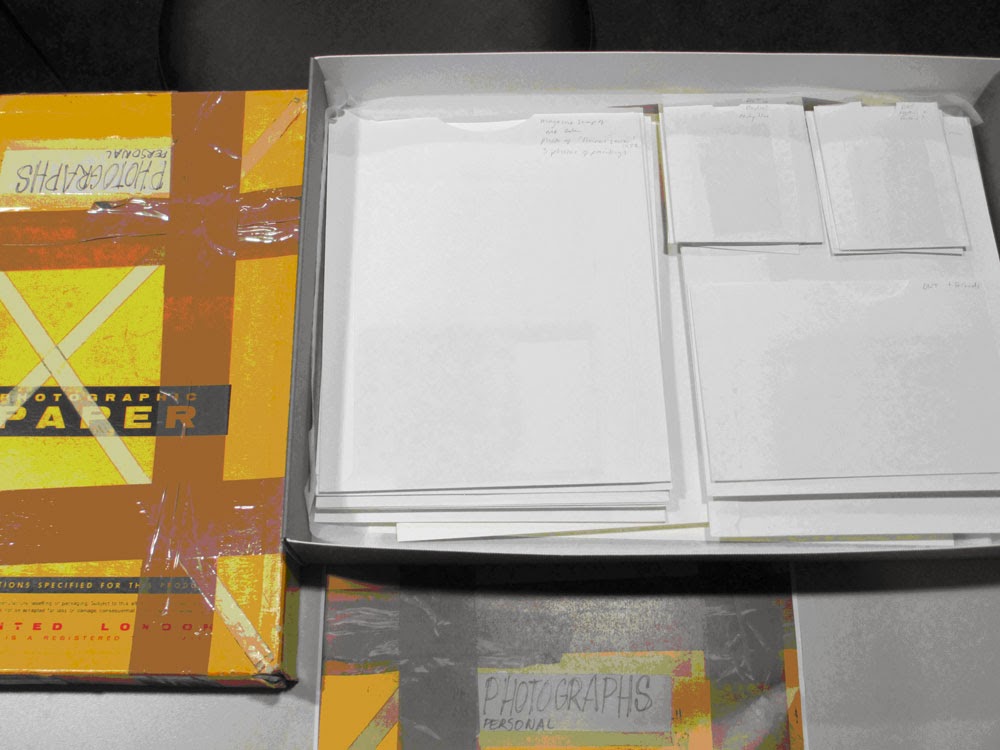Friday 13 December 2013
Hayley Webb

Dennis Turner Archive, E H McCormick Research Library, Auckland Art Gallery Toi o Tāmaki, 2013
Recently I started a practicum at the E H McCormick Research Library to learn what the work of an archivist is like within an art institution. I started out having a limited amount of knowledge of what archiving is all about after taking an archive paper at Victoria University as part of the Master of Information Studies programme. Having a background in art, I wanted to use my new found knowledge from my studies in a practical work setting that combines both of my interests.
Archiving consists of many ‘steps’ that require patience, combined with careful handling of materials. Dennis Turner’s archive arrived at the gallery in well-used boxes (as pictured on left, above), which once opened smelt musty, and of cigarette smoke. A lot of the paper and clear files were brown with age. Sometimes archives can be in a damaged condition and it can pay to check them before deciding to acquire them for an institution. However, Turner’s work was in good condition despite the smell. It was important to keep the original order of the papers as Turner had already ordered the material into folders in date order. By keeping the archive in a similar state to how it arrived, it gives a sense of the way Turner worked and ordered his own life.
The archive contains a variety of media. There is a box of personal photographs sorted into enclosures with the original captioning. In addition, there are two boxes of research drawings and four boxes of associated press clippings, photos of artworks, catalogues and a bit of correspondence. Turner was a handsome man and not shy of the camera. There are photos where he poses with his artist’s palette, violin, at the beach, studio, with friends and his artworks. The archive focuses a lot on the time when he returned to NZ in 1992 for an artist’s residency at the Sarjeant Gallery, Wanganui. His exhibition Turner’s Tiki is reflected in the archive with a large series of research drawings of tiki, moko, koru and symbol motifs dated 1991–3. Turner stated that he threw out a lot of his work from London, seemingly as a cathartic ritual for him and returned to his earlier motifs of the 1950s. I got the sense from the materials in the archive that he primarily wanted to share his experiences and interests from his time in New Zealand rather than his London years, perhaps because he was no longer interested in that work or because he thought no one here would be. Although, some of his later work can be seen on a video recording of his works called Here there here, selected works 1943–93.
The archive is a useful resource for anyone interested in Oceanic and Māori motifs and symbolic art. Reading about his frustrations with the New Zealand art world is interesting in his biographical notes. I have always been interested in looking at another’s life and their accumulated ‘stuff” which has a fascination that can touch on voyeurism. Turner has been very selective as to what he has included in the archive and does not get very personal, staying quite businesslike in the documentation of his work. If you look or read closely however, you can start to get a sense of the real person that was Dennis (Knight) Turner. His name change (which happened three times) is another interesting story explained within the artist file. In his later years, he preferred the name Dennis Turner without the Knight part, even though that is how others recognise him.
Preserving artists’ archives helps art historians to trace the context behind an artwork and adds another dimension to an artist’s legacy. The Dennis Turner archive can be viewed by appointment at the E H McCormick Research Library and Auckland Art Gallery has four of Turner’s artworks in the collection. There will also be a show on at the Gus Fisher Gallery early next year, curated by Richard Wolfe who liaised with Turner and the Auckland Art Gallery to acquire the archive.